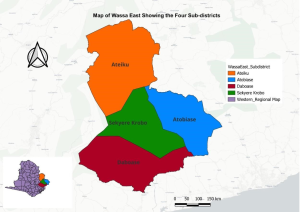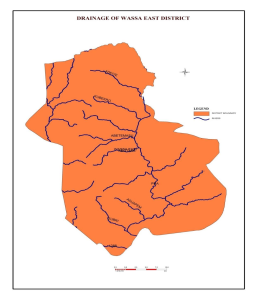Overview
The Wassa East District is located in the southeastern part of the Western Region of Ghana. It became a separate district in 2012, having previously been part of the Wassa Fiase Mpohor District since 1988. It is bordered by districts in the Central Region to the northeast and southeast, and by districts in the Western Region to the west and south. The district covers an area of 1651.992 square kilometers, with Daboase serving as its capital, located approximately 6.7 kilometers from the Cape Coast – Takoradi main road.

climate
The Wassa East District has a tropical climate with an average annual rainfall of 1500mm, ranging from 1300mm to 2000mm. It is characterized by low-lying terrain, mostly below 150 meters above sea level, with undulating landscapes averaging around 70 meters high.
relief and drainage
The district’s drainage pattern is dendritic, featuring medium and small rivers like the Pra, Subri, Suhyen, and others that flow southwards from the Akwapim Ranges towards the coast. These rivers overflow in the rainy season but often dry up in the dry season, affecting access to water, which is vital for households in the area.

soils, geology and minerals
The Wassa East District is characterized by diverse geological formations including Lower
Birimian, Cape Coast granite, and Tarkwaian soils, with Cape Coast granitic soils predominating.
Despite rich mineral deposits such as gold, iron, and kaolin, mining activities have led to water pollution, notably affecting the Pra River and other local water sources.
vegetation
The Wassa East District’s vegetation is primarily forested, originally consisting of climax climatic vegetation. Human activities like farming and logging have transformed some areas into deciduous forest, altering the landscape. The district hosts four main Forest Reserves: Subri Forest (375 sq km), Pra Suhyen Forest Reserves (204 sq km), Ben West Block Forest Reserves, and Ben East Forest Reserves, collectively known as the virgin forest areas of the district.
demographic characteristics
The District has a population of approximately 81,073 as of the 2010 census, with a growth rate of 2.1%. It has a youthful demographic profile, with 43% under the age of 14 and 53.4% aged 1564. The district’s economy is predominantly agricultural, with 78.7% of residents engaged in farming and 73% economically active. Access to ICT is limited, with only 29% owning mobile phones. Socially, 5% of the population has disabilities, and housing is primarily rural with an average household size of 4.4 persons per house. Environmental concerns include the impact of agricultural expansion and mining on forest reserves.
Source: Ghana Statistical Service 2014 (District Analytical report, 2014)
culture
The Wassa East District is governed by the Wassa Fiase paramountcy, centered in Benson with administrative operations based in Tarkwa. It comprises eight divisions, each with divisional chiefs under the paramountcy’s authority. The district celebrates cultural diversity with peaceful coexistence among its inhabitants, featuring cultural troupes in communities like Domama, Atobiase, and Daboase. Major ethnic groups include Akan, Ewe, and Dagomba, with the Wassa people predominating and speaking the Wassa language, alongside Twi, Fante, and Hausa. Festivals such as the yam festival are significant, celebrated between October and November, highlighting the district’s rich cultural heritage.
agricultural activities
The major occupation of the inhabitants in the District is agriculture. Cassava, plantain, maize, cocoyam and vegetables are the major staple food crops produced in the District. Farmers practice mainly traditional methods in farming in the District with their average farm size of one acre per farmer.
The predominant cash crops are cocoa, oil palm and rubber and coffee in some cases. Cocoa is usually cultivated in small to medium sized plantations mostly by settler farmers. Oil palm is cultivated on a large-scale by SOCFINAF Plantation Ghana, Golden Star Wassa MinesSome indigenous and settler farmers also cultivate oil palm on medium scale and small scale. Nontraditional crops like black pepper and pineapples which are cultivated in the district have high potential of becoming export crops if they are given serious attention in production and marketing. Other non-traditional crops that could do well in this district are citrus, cashew and banana.
Livestock production is also important in the district; though not on large scale due to the following reasons; lack of improved breeds, inbreeding, and lack of proper feeding and poor shelter for the animals. Even though there is some form of veterinary services.
manufacturing industries
The District has large-scale industries such as Golden Star (Wassa Mines) Limited in Akyempim, SOCFINAF plantation limited which is into growing of rubber and oil palm. Number of micro enterprises for agro-processing can be found in most part of the District.
tourism
The Wassa East District boasts several notable tourist attractions, including the Domama rock shrine, renowned as a prominent site in the Western Region and across Ghana. Additionally, the district features the Subri River Forest Reserve covering 375 square kilometers, and the Pra Suhyen Forest Reserve spanning 204 square kilometers. These reserves are known for their impressive canopy layouts, making them attractive destinations for tourists. Two smaller reserves, the Ben West Block Forest Reserve and Ben East Forest Reserve, further contribute to the district’s appeal as a destination rich in natural and cultural heritage.
communication
The district has a poor road network and condition making some of the settlements inaccessible during rainy season. Interaction between the district and other communities is difficult and expensive for that matter. There are 75 km of highways and 512 km of Feeder Roads. These have serious implications on accessibility to all basic facilities. The non-functioning railway line from Takoradi to Accra passes through New Subri and Ateiku in the northern part of the district. As a result, communities in the Northern part of the district have minimal access to markets for their agricultural produce.
Telecommunication is improving in the district with regard to mobile facilities. Only about 75 percent of the population has access to telephone services. The district, with support from the Ministry of Communication has established Community Information Centre in Daboase. The facility was designed to provide internet services, computer training, secretarial services and a library.
|
FACILITY TYPE |
FACILITY |
SCOPE OF SERVICE |
|
Hospitals |
1. Ateiku Christian Hospital |
Clinical and Public Health |
|
2. Ahmadiyya Mission Hospital |
Clinical and Public Health |
|
|
Health Centres |
2. Ateiku Health Centre |
Clinical and Public Health |
|
3. Daboase Health Centre |
Clinical and Public Health |
|
|
Clinics |
1. Akutuase Community Clinic |
Clinical and Public Health |
|
Akyempim Community Clinic |
Clinical and Public Health |
|
|
2. Dompic Community Clinic |
Clinical and Public Health |
|
|
|
3. Sekyere Krobo Communnity Clinic |
Clinical and Public Health |
|
4. Socfinaf Plantation Ghana Limited Clinic |
Clinical and Public Health |
|
|
Maternity Home |
1. Senchem Maternity Home |
Clinical and Public Health |
|
2. Glory of God Maternity Home |
Clinical and Public Health |
|
|
CHPS |
1. Brofoyedur CHPS |
Clinical and Public Health |
|
2. Kokoase CHPS |
Clinical and Public Health |
|
|
3. New Subri CHPS |
Clinical and Public Health |
|
|
4. Osenso CHPS |
Clinical and Public Health |
|
|
5. Amposaso CHPS |
Clinical and Public Health |
|
|
6. Anto CHPS |
Clinical and Public Health |
|
|
7. Beenu-yie CHPS |
Clinical and Public Health |
|
|
8. Domama CHPS |
Clinical and Public Health |
|
|
9. Aboaboso CHPS |
Clinical and Public Health |
|
|
10. Adiembra CHPS |
Clinical and Public Health |
|
|
11. Ebukrom CHPS |
Clinical and Public Health |
|
|
12. Sekyere Hemang CHPS |
Clinical and Public Health |
|
|
13. Edwenase CHPS |
Clinical and Public Health |
|
|
14. Essamang CHPS |
Clinical and Public Health |
|
|
15. Enyinabirim CHPS |
Clinical and Public Health |
|
|
16. Nsadweso CHPS |
Clinical and Public Health |
working population
|
Sub-district |
2021 |
2022 |
2023 |
2024 |
|
Sekyere Krobo |
14,301 |
14,246 |
14,545
|
14,084 |
|
Ateiku |
40,702 |
30,527 |
31,168 |
36,015 |
|
Daboase |
29,702 |
25,439 |
25,973
|
29,672 |
|
Atobiase |
25,301 |
31,544 |
32,207 |
27,737 |
|
District |
110006 |
101756 |
103893 |
107,508 |
Health Sub-districts in the Wassa East
Daboase
Ateiku
Atobiase
Sekyere Krobo
Type of Services offered by Health Institutions
Curative medical and surgical Care
Health Promotion and Preventive services including disease control and health education services
Nutrition
Reproductive and child health services
Maternity services
Units offering Health services
Medicare
Maternity
Maternal and Child Health
Disease Control
Nutrition



